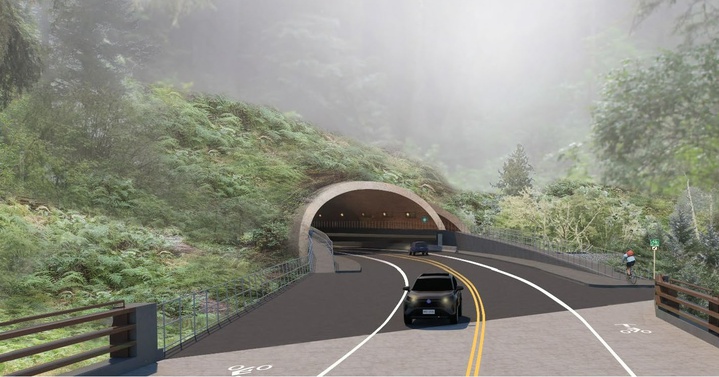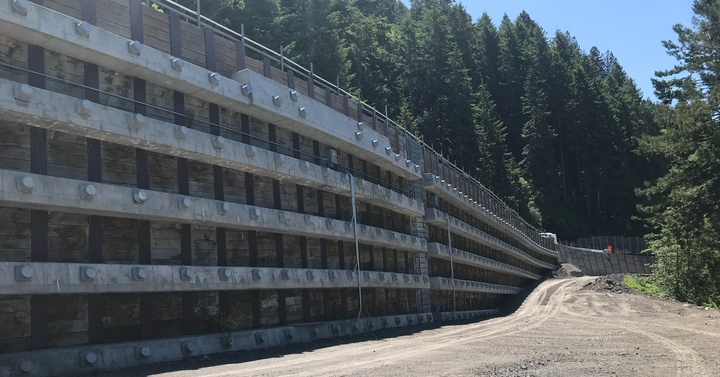Jessica Cejnar Andrews / Thursday, Jan. 25, 2024 @ 12:49 p.m. / Infrastructure, Parks, Roads
Caltrans Town Hall Does Deep Dive Into Last Chance Grade Project's Impact to Trees; Agency Expected to Decide On Preferred Alternative This Summer

Alternative F, one of two potential permanent bypasses around Last Chance Grade, involves a 6,000 foot tunnel and includes a $1.4 billion price tag. | Image courtesy of Caltrans District 1
While consultants say the two alternatives singled out for Last Chance Grade carry fewer environmental impacts than others Caltrans has considered over the years, both involve removing more than 100 large-diameter trees.
This includes old-growth redwoods, said John Cook, CEQA/NEPA project manager for ICF, one of the consultants working with Caltrans.
“Part of the reason why this project has gone on for so many years is that many efforts have been made to try to avoid and minimize impacting the redwoods and other older growth trees that are such an integral part of Redwood National and State Parks,” Cook said.
Cook and other scientists working with the department presented the findings of a draft environmental impact document on Alternatives X and F at a virtual town-hall meeting Wednesday.
Both are being considered as a permanent solution to the slide-prone area of U.S. 101 south of Crescent City. Congressman Jared Huffman pointed out that Caltrans has spent decades applying Band-aids to the highway to keep it open.
Public comment on the draft environmental document will be accepted through Feb. 13 and Caltrans is expected to select the preferred alternative by this summer. Comments can be sent to Caltrans via email by clicking here.
“In my entire coastal district from the Golden Gate Bridge to the Oregon border, nothing compares to Last Chance Grade in its importance, its urgency and its complexity,” Huffman said. “This is going to be a difficult, costly and ambitious endeavor no matter which of these alternatives is chosen. If you take a hard look at the draft EIR/EIS, you’ll see that there are significant impacts, including to old-growth trees. I wish that was not the case, but I think we’ve just got to be clear-eyed about the realities in trying to make this roadway safe for the long haul.”
Caltrans and several stakeholder groups, including one founded by Huffman, have been working to find a permanent solution around Last Chance Grade since 2015. Since that time, the agency had considered six alternatives for re-routing the highway along with a seventh no-build option leaving the alignment where it is.

Alternative X would continue to incorporate retaining walls into the highway. | Image courtesy of Caltrans District 1
Caltrans whittled those seven alternatives down to Alternative X and F using environmental and engineering data collected in 2021 and paid for through a $50 million allocation from the California Transportation Commission.
One of the alternatives, Alternative X, stays closer to the existing roadway and consists of deploying a drainage system under the landslide to relieve the water pressure and reduce movement. It will also install a 1.6 mile-long retaining wall that’s tiered to help reduce impacts to old growth trees further up the slope, according to John Litzinger, a consultant with HNTB.
Alternative X is the cheaper of the two alternatives at $580 million in 2022 dollars. By the time construction is expected to start in 2031, Alternative X’s cost would be a projected $880 million, according to Caltrans.
Since this alternative stays closer to the existing roadway, trees and other resources area already being affected by the highway. According to Litzinger, Alternative X has more of an impact on red alder and Sitka spruce forest than redwood forest.
Alternative X will also be quicker to build out, according to Caltrans.
Alternative F’s primary feature is a 6,000-foot-long tunnel that would largely avoid the landslides, though not completely. With a 2022 estimated price tag of $1.4 billion — $2.1 billion in 2031 dollars — this alternative includes an operations building at its southern end.
The tunnel’s northern portal would also go through old-growth redwood forest.
According to Cook, both alternatives would have impacts on two federally protected species, the marbled murrelet and the northern spotted owl, which nest in mature conifer forests.
“We know marbled murrelets are present in the Last Chance Grade area,” he said. “We did surveys for the northern spotted owl. We didn’t find any during the surveys, but it’s certainly assumed that the species could be present at any time given the forest features.”
During a deeper dive of the project’s impacts on trees, Maggie Townsley, ICF vice president of environmental planning, said Alternative X would disturb 15.71 acres, while Alternative F — the tunnel alternative — would disturb 23.25 acres.
Alternative X involves removing 129 trees, while Alternative F involves removing a total of 144 trees, according to Townsley.
The first alternative involves removing more of the larger coastal redwoods than the tunnel option, she said. However, Alternative F would remove 12 redwood trees with a diameter greater than 5 feet. Alternative X involves removing six redwood trees with a diameter greater than 5 feet, according to Townsley’s presentation.
When it comes to mitigate the impacts the project will have on the region’s trees, Townsley referred to Redwood National and State Parks’ Redwoods Rising Initiative, which aims to speed up the proliferation of old growth characteristics in what’s currently a crowded second-growth forest.
“[Mitigation] could include providing funding for thinning projects within dense early successional [forest] stands,” Townsley said. “Finding endowments for long-term management of treated stands or researching them. Or it could involve improving stream habitat…. The goal of this mitigation option would be to accelerate the transition of a stand to a healthier more sustainable old growth character stand.”
Another mitigation option would be preserving existing old growth forest habitat through purchases of land that are slated for logging or development, Townsleys aid. This would also help offset impacts to marbled murrelets and other species in the Last Chance Grade area, she said.
Once the public comment period on the draft environmental document closes Feb. 13, Townsley and other scientists will review and respond to comments and revise the document.
During the question and answer segment of Wednesday’s town-hall meeting, one commenter asked if an attempt was made to avoid Redwood National and State Parks and the sensitive habitats they house completely.
Steve Croteau, Caltrans District 1 senior environmental scientist, said such a bypass would start “well south” of Last Chance Grade and would need to connect with U.S. 199 in the north.
This would involve a bypass of 15-20 miles, Litzinger said, and were among the longer alternatives investigated and dropped before 2019.
Before Caltrans’ consultants presented the findings of the draft environmental document on Wednesday, Redwood National and State Parks Superintendent Steve Metz spoke.
He noted that preserving the park’s resources, primarily old-growth redwoods, and supporting the Last Chance Grade project was a “tricky balance.” However, finding a safe route around Last Chance Grade has always been a high priority, Metz said.
“We care about protecting the forest, of course, but we also care about the community. Our employees are part of the community. I’m part of the community,” he said. “We also care about our visitors and giving them a safe reliable corridor through this area.”
Public comments can be mailed to Steve Croteau, of Caltrans, at P.O. Box 3700 Eureka, CA 95502.
CLICK TO MANAGE